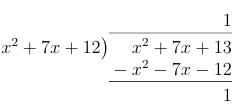When integrating a rational function where the degree of the numerator is greater than or equal to the degree of the denominator, polynomial long division becomes a valuable tool for simplifying the integral. In this guide, we’ll look at how to integrate using polynomial long division and work through a step-by-step example to solidify your understanding.
This article is part of a three-part series on integrals of rational functions. To learn this topic visually, please refer to the Integrating Rational Functions Infographic.
Polynomial Long Division
Before integrating, let’s review polynomial long division. This process allows us to rewrite an improper rational function into a sum of a polynomial and a proper fraction, making integration possible with other methods like partial fraction decomposition or completing the square, and maybe even simpler methods.
A proper rational function has a numerator with a degree less than the degree of the denominator. In comparison, an improper rational function has a numerator with a degree greater than or equal to the degree of the denominator. When faced with the latter, polynomial long division helps us write the rational function as the sum of a polynomial and a proper rational function.
Steps to Integrating Using Polynomial Long Division
Step 1: Check That the Rational Function is Improper
Check to make sure the degree of the numerator is greater than or equal to the degree of the denominator. If not, try a different method.
Step 2: Use Polynomial Long Division to Rewrite the Rational Function
We demonstrate this process by rewriting \( \frac{x^2 + 7x + 13}{x^2 + 7x + 12} \).
We first perform polynomial long division:
We now rewrite our function according to the word equation
$$\frac{dividend}{divisor} = quotient + \frac{remainder}{divisor}.$$
In our case, this gives
$$\frac{x^2 + 7x + 13}{x^2 + 7x + 12} = 1 + \frac{1}{x^2 + 7x + 12}.$$
Step 3: Integrate Term-by-Term
The polynomial function can be integrated using the methods covered in the article Basic Integration Problems for Beginners. These methods may also be used to integrate the rational function, but in all likelihood, you will need the techniques covered in The Ultimate Step-by-Step Guide to Solving Integrals Using Substitution or The Ultimate Guide on How to Solve Integrals by Completing the Square to solve it.
Partial fraction decomposition may also be needed. To learn how to find the partial fraction decomposition of a rational function, please check out A Comprehensive Beginner’s Guide to Partial Fraction Decomposition. The article Partial Fraction Decomposition Integration Problems with Solutions: A Complete Tutorial shows how partial fraction decomposition is used to integrate rational functions.
Worked Out Examples
We now give an example.
Example 1: Evaluate \( \int \frac{2x^3 + 13x^2 + 26x + 11}{x^2 + 6x + 10}dx \).
Solution: We first perform polynomial long division:
Rewriting the fraction then gives
$$\int 2x + 1 + \frac{1}{x^2 + 6x + 10}dx = \int 2x + 1 dx + \int \frac{1}{x^2 + 6x + 10}dx.$$
We now complete the square in the denominator of the second integral to get
$$\int 2x + 1 dx + \int \frac{1}{x^2 + 6x + 9 + 1}dx = \int 2x + 1 dx + \int \frac{1}{(x + 3)^2 + 1}dx. $$
Let \( u = x + 3 \), the \( du = dx \). Substituting into the second integral, we get
$$\int 2x + 1 dx + \int \frac{1}{u^2 + 1}du = x^2 + x + \arctan{u} + C = x^2 + x + \arctan{(x + 3)} + C.$$
Example 2: Evaluate \( \int \frac{x^2 + 7x + 13}{x^2 + 7x + 12}dx \).
Solution: We first perform polynomial long division:
Rewriting the fraction then gives
$$\int 1 + \frac{1}{x^2 + 7x + 12}dx = \int 1 + \frac{1}{(x + 3)(x + 4)}dx.$$
We now need to find the partial fraction decomposition of \( \frac{1}{(x + 3)(x + 4)} \). Setting up the partial fraction decomposition, we get
$$\frac{1}{(x + 3)(x + 4)} = \frac{A}{x + 3} + \frac{B}{x + 4}.$$
Next, multiplying both sides by \( (x + 3)(x + 4) \) gives
$$1 = A(x + 4) + B(x + 3).$$
Now we solve for the coefficients by choosing convenient values of x:
$$x = -3 \Rightarrow 1 = A$$
$$x = -4 \Rightarrow 1 = -B \Rightarrow -1 = B.$$
Thus,
$$\frac{1}{(x + 3)(x + 4)} = \frac{1}{x + 3} – \frac{1}{x + 4}.$$
Our integral is then
$$\int 1 + \frac{1}{x + 3} – \frac{1}{x + 4}dx = x + \ln{|x + 3|} – \ln{|x + 4|} + C = x + \ln{|\frac{x + 3}{x + 4}|} + C.$$
Conclusion
Polynomial long division is an important tool in integration, especially when dealing with improper rational functions. By mastering this technique, along with completing the square and partial fraction decomposition, you can, at least in theory, integrate any rational function.


